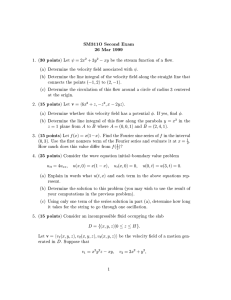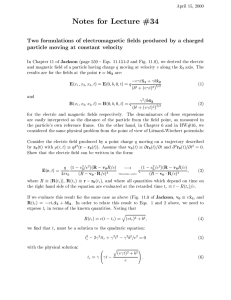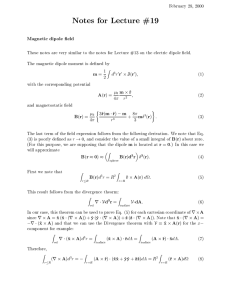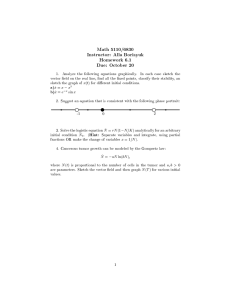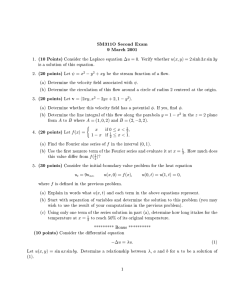The Environmental Liability Directive: A Critical Evaluation of the Potential Effectiveness for Preventing and Remediating Environmental Damage in the European Community
advertisement
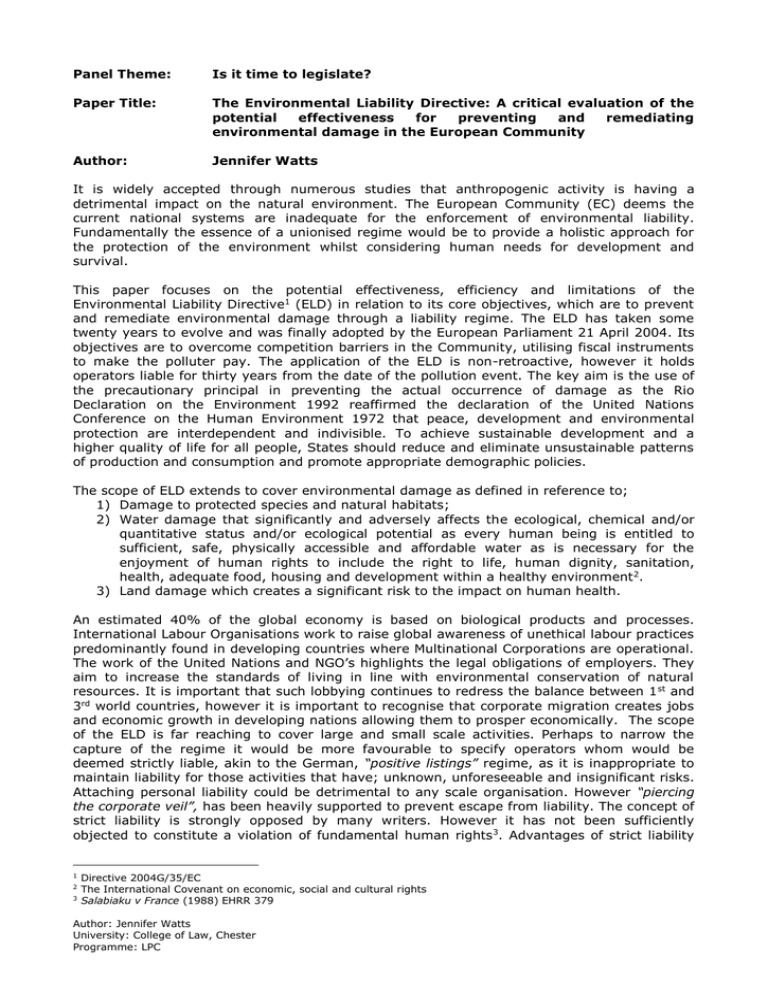
Panel Theme: Is it time to legislate? Paper Title: The Environmental Liability Directive: A critical evaluation of the potential effectiveness for preventing and remediating environmental damage in the European Community Author: Jennifer Watts It is widely accepted through numerous studies that anthropogenic activity is having a detrimental impact on the natural environment. The European Community (EC) deems the current national systems are inadequate for the enforcement of environmental liability. Fundamentally the essence of a unionised regime would be to provide a holistic approach for the protection of the environment whilst considering human needs for development and survival. This paper focuses on the potential effectiveness, efficiency and limitations of the Environmental Liability Directive1 (ELD) in relation to its core objectives, which are to prevent and remediate environmental damage through a liability regime. The ELD has taken some twenty years to evolve and was finally adopted by the European Parliament 21 April 2004. Its objectives are to overcome competition barriers in the Community, utilising fiscal instruments to make the polluter pay. The application of the ELD is non-retroactive, however it holds operators liable for thirty years from the date of the pollution event. The key aim is the use of the precautionary principal in preventing the actual occurrence of damage as the Rio Declaration on the Environment 1992 reaffirmed the declaration of the United Nations Conference on the Human Environment 1972 that peace, development and environmental protection are interdependent and indivisible. To achieve sustainable development and a higher quality of life for all people, States should reduce and eliminate unsustainable patterns of production and consumption and promote appropriate demographic policies. The scope of ELD extends to cover environmental damage as defined in reference to; 1) Damage to protected species and natural habitats; 2) Water damage that significantly and adversely affects the ecological, chemical and/or quantitative status and/or ecological potential as every human being is entitled to sufficient, safe, physically accessible and affordable water as is necessary for the enjoyment of human rights to include the right to life, human dignity, sanitation, health, adequate food, housing and development within a healthy environment 2. 3) Land damage which creates a significant risk to the impact on human health. An estimated 40% of the global economy is based on biological products and processes. International Labour Organisations work to raise global awareness of unethical labour practices predominantly found in developing countries where Multinational Corporations are operational. The work of the United Nations and NGO’s highlights the legal obligations of employers. They aim to increase the standards of living in line with environmental conservation of natural resources. It is important that such lobbying continues to redress the balance between 1 st and 3rd world countries, however it is important to recognise that corporate migration creates jobs and economic growth in developing nations allowing them to prosper economically. The scope of the ELD is far reaching to cover large and small scale activities. Perhaps to narrow the capture of the regime it would be more favourable to specify operators whom would be deemed strictly liable, akin to the German, “positive listings” regime, as it is inappropriate to maintain liability for those activities that have; unknown, unforeseeable and insignificant risks. Attaching personal liability could be detrimental to any scale organisation. However “piercing the corporate veil”, has been heavily supported to prevent escape from liability. The concept of strict liability is strongly opposed by many writers. However it has not been sufficiently objected to constitute a violation of fundamental human rights 3. Advantages of strict liability 1 2 3 Directive 2004G/35/EC The International Covenant on economic, social and cultural rights Salabiaku v France (1988) EHRR 379 Author: Jennifer Watts University: College of Law, Chester Programme: LPC are the reflection of public interest in making the polluter pay and the ease of enforcement for the prosecution. The European Environmental Bureau (EEB) applauds the strict regime as it creates incentives for operators to be diligent beyond existing standards and provides for an efficient and integrated approach for environmental policy. There are exceptions to the ELD which include threats or damage caused by ‘war’ or ‘force majeure’. There are two optional defences available to MS where the operator demonstrates there was no fault or negligence and that environmental damage was caused as a result of an operator complying with ‘permit conditions’ for example the harm may be excused, under Article 8(2) if it results from an authorised activity of economic benefit to the community in general, as long as there is no disproportionate burden on any particular individual. There is also the ‘state of the art technology’ defence were it is envisaged that operators will invest in pollution prevention technology as a more economically viable option in comparison to expenditure on remediation orders. If contamination clean up is not feasible due to economic or technical constraints then an option for containment should apply and compensation be imposed through the enhancement of other equivalent protected natural resources. In this instance, consideration to local factors should be paramount, to include; proximity to the contaminated site; social, economic and cultural concerns; the perceived effectiveness of the project and the potential of future damage. As environmental legislation embodies its principals in enforcing responsible trading and good business practice it simultaneously enhances the conditions and environment of those involved in the chain, thus enhancing their human rights. A provision of Article 1 of Protocol 1 ensures that every natural or legal person is entitled to the peaceful enjoyment of his possessions. The European Commission accepts that pollution or other environmental harm may result in a breach, but only where such harm results in a substantial reduction in the value of the property and that reduction is not compensated by the state, for example the right to housing states that housing should not be built on polluted sites nor in proximity to pollution sources that threaten the right to health of the inhabitants. It would also be important to assess like-for-like comparisons between sites to adequately compensate for the original damage done and provide for an equal if not a higher standard of the conditions which had existed. Environmental Citizens Organisations have a crucial role to play in the implementation of the ELD provisions into national laws. Their position in lobbying Government Bodies will be paramount in the success of the long awaited ELD, specifically issues that have been raised in the consultation process with regards to rights under access to justice. The structure and context of the Aarhus Convention are rights-oriented. In part, the Convention draws on notions of international human rights law. It is intended to provide for participatory, informational and procedural rights in environmental matters, and a failure to do so would imply a breach of the treaty. The ELD is considerably diluted and leaves a void in several key areas. It would be hoped that by and large, MS’s will cease the opportunity to revitalise their current systems and implement the advantageous elements of the ELD with the flexibility to build upon existing national arrangements. A unique feature is the advantages the ELD brings for the protection and remediation of species rich habitats as there is no single MS currently maintaining a system for the direct protection of biodiversity. The opportunity for MS’s to extend the regime to include a wider spectrum of species could significantly improve protection for biodiversity. What is clear is that human beings are at the centre of concerns for sustainable development. They are entitled to a healthy and productive life in harmony with nature. Thus what is needed for long term sustainability is a globalised partnership to conserve the integrity of our environment, with development being fulfilled so as to equitably meet developmental and environmental needs of present and future generations. The ELD has not been transposed into UK law. DEFRA is aiming to launch the second consultation in spring 2008. It is yet to be seen whether the ELD provides for an explicit right to a safe and sound environment incorporating existing legal frameworks and further the international values represented by environmental law and human rights. Author: Jennifer Watts University: College of Law, Chester Programme: LPC




